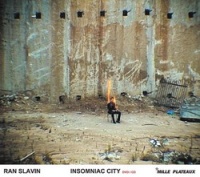 Did I die? Did I kill?... that are first words of the new work (19th of May 2006) of audio-designer and musician Ran Slavin on regenerated Mille Plateaux records.
Did I die? Did I kill?... that are first words of the new work (19th of May 2006) of audio-designer and musician Ran Slavin on regenerated Mille Plateaux records.Insomniac City is a psychedelic experience into the world of non-existant but attractive illusions of something that hides somewhere in the labyrinths of a huge megalopolis.
This city suffering from insomnia is a multiplot story which tells us about insane changes of a person and surrounding reality. It represents all possible variants of actions which happened and are happening to the main hero who tries to understand what's really going on.
All plots are connected with the main theme of the town - all shootings were made in Tel Aviv by the author of the project + the help of his friends. Sometimes camera moves out of the city streets and dives into the water starting a new video block of underwater shootings. A lost person got lost in lost spaces of a lost city. Most likely it's a supposed plot line for the whole film. Soundtrack for the film is one of the most driven off soundtracks far from the borders of mentality. It's absolutely impossible to compare it with anything else, unless genious, odd sound works of legendary English band Hafler Trio, but that was rather long ago. Frequent tone changes, noise threshing, fragments of the play of musical instruments and voices cut into small micro-pieces.
Musical experiments in this album resemble in some way the creativity of Jan Jelinek and his last work Kosmischer Pitch, where the same collection of instruments plays like a mini-orchestra. By the way, the main instruments of this sound phantasmagoria are not samplers and programs but acoustic instruments. Electronical music gradually turns to acoustic instruments - guitars, sampled wind instruments, jazz percussion. All this lives, breathes and developes in some colossal, amazing way.
Paranoid plot of the film Insomniac City in the style of Kenneth Anger (an odd director who influenced David Lynch) cause gloomy thoughts in the middle of viewing, sometimes it may seem that the picture on the screen is someone's dream or hallucination.
Auditory sensations are almost the same - mad conductor leads his own perception through feelings, words and emotions. He makes them penetrate into the plot of the actions happening and understand them in an unusual way.
Perhaps recording music is not enough nowadays, sometimes it's worth to add to it high-quality images.
- Ran Slavin
- Mille Plateaux
